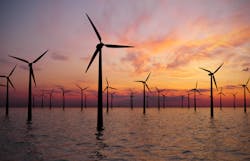US offshore wind market could see rapid growth
The stars may finally align in 2021 to attract record investment in the US offshore wind industry, unlocking the nation’s largest unrealized decarbonization solution. Offshore wind could be critical to enabling the targets of decarbonizing utilities, states, and corporations, and these goals may soon be teamed with federal efforts to fully decarbonize the power sector by 2035.
Offshore wind has several key advantages over onshore wind and solar photovoltaics. While the latter two renewable sources have become the lowest-cost energy sources in many regions on an unsubsidized basis, they need to be able to meet several times the peak demand to ensure adequate generation at times of low solar and wind resource availability. Offshore wind, which is also recording a rapidly falling levelized cost of energy (LCOE) – 67% decrease since 2012 for fixed wind – has relatively high and rising capacity factors and deployment potential. In addition to LCOE reductions and capacity factor increases, the larger rotors and taller towers deployable offshore can lower transmission, grid balancing, and financing costs. Location is another advantage. Offshore wind can be deployed at a large scale close to the major coastal cities that account for most electricity demand. While the US offshore wind industry is nascent, deployment could quickly ramp up given that fixed offshore wind is an established technology, undergirded by a mature industry with a proven global track record for deployment.
The evolving floating wind technology is also becoming increasingly competitive: its LCOE has halved since the first pilot project, and is positioned to further decrease as non-recourse financing becomes available, and demonstration projects proceed. Developers are also exploring enhanced structures that could lower costs via hybridization of floating platforms with complementary tidal, wave, and ocean thermal energy generation, as well as floating solar generation. Floating wind can be deployed in deeper water, potentially opening much of the US coast to offshore wind development. In fact, if the US harnessed its full estimated potential, offshore wind could meet double the country’s total electric demand.
Offshore wind’s advantages have already allowed the industry to continue attracting global investment throughout the pandemic. Investors poured a record $35 billion into offshore wind in the first half of 2020. Most recently, in the US, BP invested $1.1 billion in September to acquire a 50% stake in Equinor’s Empire Wind (NY) and Beacon Wind (MA) projects and to potentially participate in additional projects. Other oil and gas companies are poised to leverage their deep expertise in offshore environments – including offshore wind for some – to stake leading positions in a nascent US industry that can provide relatively stable revenues while lowering their carbon footprint. Oil companies also seem well positioned to hybridize offshore wind projects with green hydrogen production – another new industry in an area of oil industry expertise.
State actions have further boosted the US offshore wind industry. The US already has a 20 GW pipeline of projects announced and/or under development, and a 30 GW market by 2035 created by state mandates alone. Despite the pandemic, states have also proceeded with plans to develop domestic supply chains that are expected to shape the industry’s growth in 2021 and help further lower costs. For example, the state of New York has committed $400 million in public and private funding for port infrastructure to support the industry. Meanwhile, New Jersey has announced plans for an offshore wind port to serve as a hub for staging, assembly and manufacturing of offshore wind projects. And most recently, Maryland, Virginia, and North Carolina announced a collaboration to facilitate offshore wind manufacturing and infrastructure development across the three states.
Federal support could boost these strong market fundamentals and proactive state efforts in 2021. In addition to proposed federal decarbonization targets, a possible $2 trillion investment to enable them, and executive powers over emissions, federal support in several key areas would likely spur the additional investment needed for offshore wind to play a greater role in decarbonization.
While the US offshore wind industry is off to a late start compared with its European and Chinese counterparts, it could also be set for rapid growth as domestic players partner with experienced global developers, and as market fundamentals and state and federal actions will likely combine to accelerate the energy industry’s transition and convergence in 2021. The US offshore wind industry may attract record investment in 2021 as it starts realizing its massive potential while boosting emerging technologies that complement its generation profile (e.g. other marine renewables, floating solar) and maximize its value (e.g. green hydrogen). Signposts to watch for in 2021 include the extent to which new technologies, their hybridization, and domestic supply chain development continue to lower costs.
The authors
Marlene Motyka is US and Global Renewable Energy Leader, Deloitte Transactions and Business Analytics LLP.
Carolyn Amon is Manager, Deloitte Research Center for Energy & Industrials, Deloitte Services LP.
